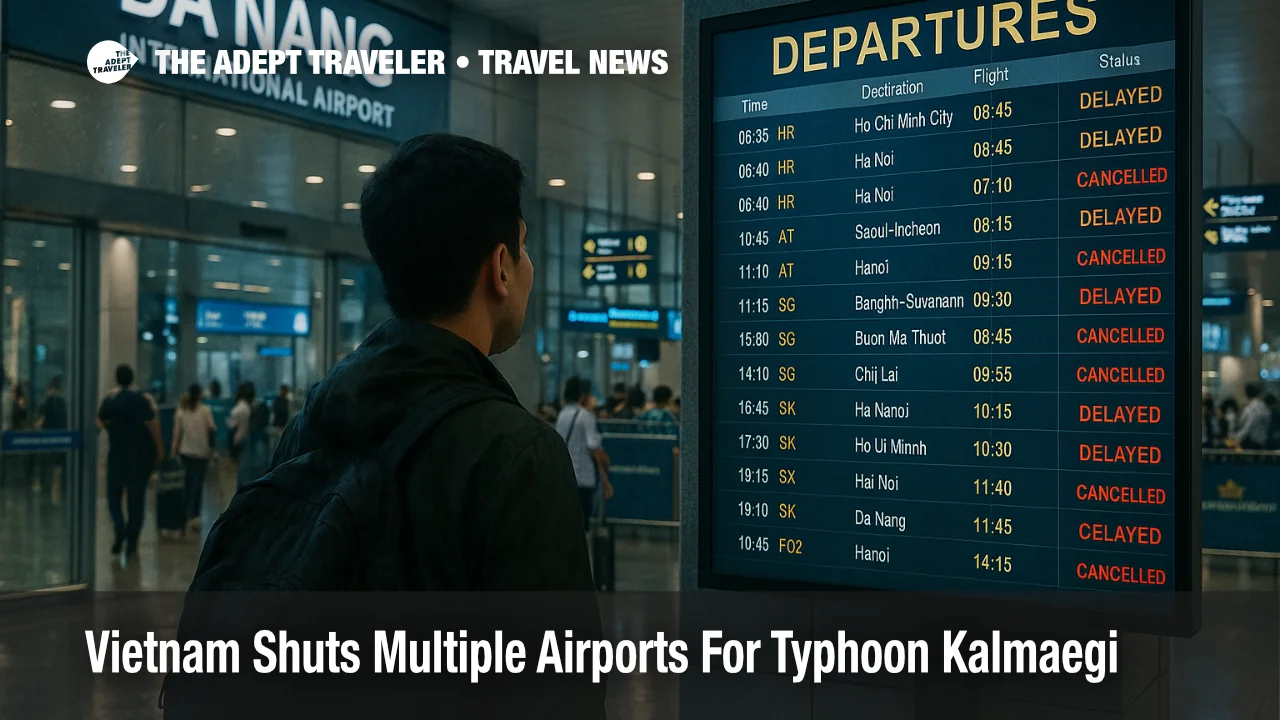Vietnam Shuts Multiple Airports For Typhoon Kalmaegi, More Than 50 Flights Disrupted

Key points
- Six central Vietnam airports paused operations between the afternoon of November 6 and early November 7 for Typhoon Kalmaegi
- Vietnam Airlines canceled and rescheduled more than 50 flights on November 6-7 and warned of follow-on delays as aircraft reposition
- VietJet issued targeted adjustments and guidance for Da Lat, Tuy Hoa, Quy Nhon, and Chu Lai services
- Additional airports including Da Nang and Phu Bai warned of potential knock-ons though not universally closed
- Travelers should build buffers for transfers and monitor same-day status as rotations normalize
Central Vietnam temporarily closed or curtailed operations at multiple airports as Typhoon Kalmaegi made landfall late November 6 and into the early hours of November 7. The Civil Aviation Authority of Vietnam ordered suspensions at Phu Cat, Tuy Hoa, Chu Lai, Pleiku and others on a timed basis, while carriers pre-emptively canceled and rescheduled flights. Vietnam Airlines alone adjusted more than 50 services across November 6-7, and VietJet issued targeted guidance for Da Lat, Tuy Hoa, Quy Nhon and Chu Lai. Even where airfields did not fully close, travelers should expect rolling delays as aircraft and crews return to position.
Central Vietnam closure windows and scope
Authorities published precise suspension windows by airport as the storm approached. Phu Cat paused from the afternoon of Thursday, November 6, into early Friday. Tuy Hoa had a shorter afternoon closure on November 6. Chu Lai halted from the evening of November 6 until the early hours of November 7. Pleiku's suspension extended from late evening into early morning. Buon Ma Thuot and Lien Khuong, farther inland and to the south, also suspended operations for portions of Thursday night. Taken together, the closures covered the core impact period of Kalmaegi's landfall and early inland track, with additional alerts posted for Da Nang and Phu Bai where significant knock-ons remained possible even without a full-field stop.
Airline changes and waivers
Vietnam Airlines canceled and rescheduled more than 50 flights for November 6-7, including Ho Chi Minh City-Phu Cat rotations and select Hanoi-Phu Cat and Ho Chi Minh City-Chu Lai services that were advanced earlier in the day or pushed later, depending on weather and airfield status. The flag carrier warned customers to monitor emails and app notifications for reaccommodation and to expect delays on November 7 while aircraft reposition.
VietJet issued an advisory ahead of landfall, flagging temporary adjustments to Da Lat, Tuy Hoa, Quy Nhon, and Chu Lai routes on November 6, with instructions for free changes within the carrier's storm policy window. Travelers can process eligible changes via self-service channels or contact centers, subject to availability once operations resume.
Additional regional reporting noted eight airports with potential effects, including Da Nang, and confirmed the government's coordinated response. As conditions eased, authorities signaled a shift from closure to cleanup and reopening, but cautioned that runway inspections, staffing, and slot availability could prolong the return to normal.
Latest developments
By Friday morning, closures had largely lifted within the published windows, and carriers began working through backlogs. However, recovery flying often cascades: a Thursday cancellation in Quy Nhon can ripple to a Friday afternoon departure elsewhere if the aircraft and crew were meant to continue onward. Expect the busiest peaks at the first post-closure "bank" of departures and again in the evening as airlines try to restore rotations.
Analysis
For travelers headed to Da Nang, Quy Nhon, Da Lat, and Tuy Hoa, the main risk on November 7 is not a fresh shutdown but residual disruption from aircraft and crew out of place. If you were booked to, from, or through affected airports during the closure times, check your booking for an automatic move, then decide whether to keep it or shift to a more reliable earlier or next-day option. When your trip includes a connection, try to protect the itinerary by selecting a longer layover until same-day on-time performance improves.
Background
Vietnam's aviation regulator typically issues time-boxed suspensions aligned to a storm's strongest forecast impacts, then reopens as soon as inspections confirm runway and lighting conditions are safe. Airlines plan around those windows by pre-canceling vulnerable sectors, advancing some earlier flights to beat the weather, and staging spare crews where possible. The first wave after reopening is often oversubscribed, which can slow baggage and security queues even if your flight is on time.
Surface-transfer advice
Road and intercity-bus alternatives may be limited during heavy rain, especially across the Central Highlands and mountain passes. If you must go overland, wait for local authorities to clear primary highways, avoid night driving on flooded routes, and prefer daytime buses on major corridors once services resume. If you are moving between coastal cities, consider staging in Da Nang once your airline confirms a reliable seat, rather than attempting multi-leg bus connections during the weather window.
Final thoughts
Time-boxed airport closures around Typhoon Kalmaegi reduced risk during the worst weather, but recovery takes longer than a single night. Build slack into today's plans, use self-service tools to capture reaccommodation, and recheck status repeatedly until wheels-up from your origin.
Sources
- Six Airports Temporarily Closed Due To Typhoon Kalmaegi
- 6 Central Vietnam Airports Suspend Operation As Typhoon Kalmaegi Nears Landfall
- Over 50 Flights Canceled, Rescheduled As Typhoon Kalmaegi Nears Central Vietnam
- Aviation Authority Issues Storm Alert, Airlines Adjust Schedules
- Vietnamese Carriers Cancel, Delay Flights Due To Looming Typhoon
- Notice On The Impact Of Typhoon No.13 (Kalmaegi) - VietJet
- Eight Airports Directly Affected By Typhoon Kalmaegi
